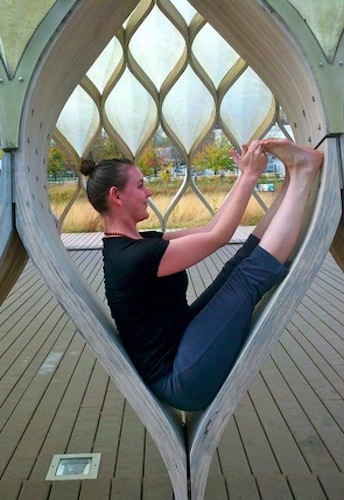It wasn’t until recently that I had an impulse to practice yoga completely on my own.
I unfurled my mat to an empty floor, consummating a desire that was itching quietly but intensely for probably months. Practice alone.
My first self-practice lasted longer in fantasy than in reality: peppered by small trips to the bathroom and a few fidgety email checks on my phone, sun salutations broken apart by distractions and put back together again by an ujjayi that seemed to stick in my throat.
The second practice started with a little more concentration, dropping to my knees and bending forward into a child’s pose that lasted longer than any child’s pose I’d ever done in a public setting. A pose that was not dictated to me by someone else or even by my mind, but was cultivated and expressed to release all the things that I am not.
The third practice seemed to start itself, taken by the intention—or desire—to spend time with myself, as myself.
The question: who am I?
Drawing me deeper into breath, deeper into asana, deeper into savasana, deeper into the knowing space I call myself.
And what didn’t seem to interest me much six months ago has suddenly become alive and inspired—a self yoga practice.
This is an experience I am interested in giving to myself, again and again.
It is an experience I am interested in sharing with others—not to teach others how to practice by themselves, but to hold the notion firmly that we all already know how to practice on our own, because the only requisite for self-practice is to be exactly who we are.
Of course, to have an asana-based self-practice requires some knowledge of the asanas, but it mostly requires the ability to be sensitive and calm during the physical exploration of the poses. This means you can have a self-practice at any stage in your yoga development.
If you’re a yoga teacher, I know it can be hard to find time and space for our own practice, as we spend hours upon hours each day facilitating the practice of others. And since teaching yoga isn’t a big bill-payer (for most of us), a full-time yoga teacher may cram a day with four or five classes, making a yoga mat the last choice for hanging out when the day finally brings us back home.
And if you’re a yoga student, it can be difficult to feel ready or prepared for self-practice, mostly because we learn yoga in group settings and—for the most part—rely on our teachers to feed our body-intelligence to us.
The desire to practice on one’s own may not even be cultivated, as we are so used to practicing around others that we may start to derive part of our yogic-satisfaction from the bells and whistles of learning and executing in a group.
But the purpose of self-practice is not to deepen the expression of the poses, it’s simply to know ourselves, which is different than knowing the idea that we create about ourselves and who we are.
There are as many different approaches to a self-practice as there are practitioners and the only relevant approach is the one that makes us feel connected to who we already are and have always been—ourselves.
This video offers some helpful guidance for how to approach your movement when it’s just you and yourself at the top of the yoga mat.
~
Love elephant and want to go steady?
Sign up for our (curated) daily and weekly newsletters!
~
~
Editor: Ashleigh Hitchcock
Photo: wixstatic







Read 0 comments and reply